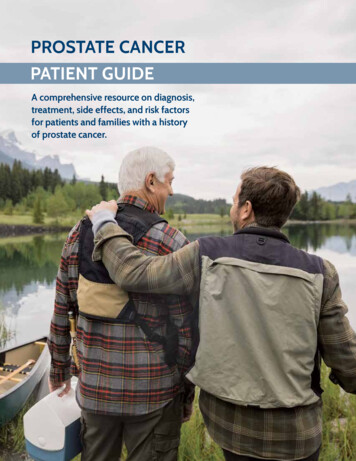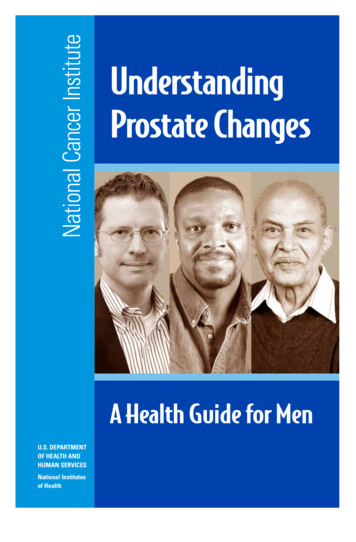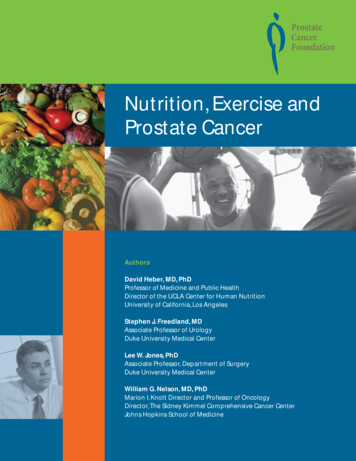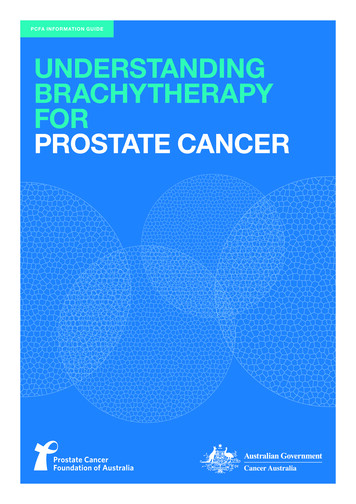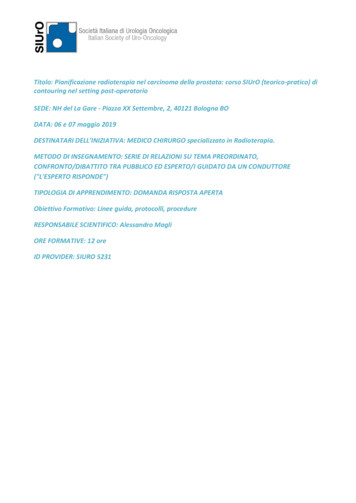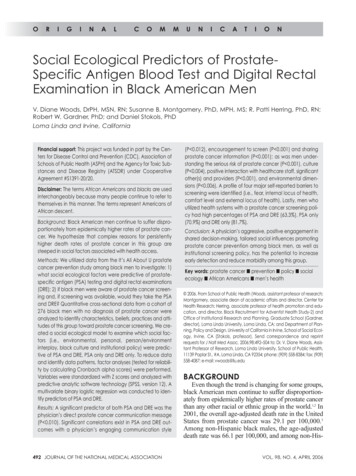
Transcription
ORIGINALCOMMUNICATIONSocial Ecological Predictors of ProstateSpecific Antigen Blood Test and Digital RectalExamination in Black American MenV. Diane Woods, DrPH, MSN, RN; Susanne B. Montgomery, PhD, MPH, MS; R. Patti Herring, PhD, RN;Robert W. Gardner, PhD; and Daniel Stokols, PhDLoma Linda and Irvine, CaliforniaFinancial support: This project was funded in part by the Centers for Disease Control and Prevention (CDC), Association ofSchools of Public Health (ASPH) and the Agency for Toxic Substances and Disease Registry (ATSDR) under CooperativeAgreement #S1391-20/20.Disclaimer: The terms African Americans and blacks are usedinterchangeably because many people continue to refer tothemselves in this manner. The terms represent Americans ofAfrican descent.Background: Black American men continue to suffer disproportionately from epidemically higher rates of prostate cancer. We hypothesize that complex reasons for persistentlyhigher death rates of prostate cancer in this group aresteeped in social factors associated with health access.Methods: We utilized data from the It’s All About U prostatecancer prevention study among black men to investigate: 1)what social ecological factors were predictive of prostatespecific antigen (PSA) testing and digital rectal examinations(DRE); 2) if black men were aware of prostate cancer screening and, if screening was available, would they take the PSAand DRE? Quantitative cross-sectional data from a cohort of276 black men with no diagnosis of prostate cancer wereanalyzed to identify characteristics, beliefs, practices and attitudes of this group toward prostate cancer screening. We created a social ecological model to examine which social factors (i.e., environmental, personal, person/environmentinterplay, black culture and institutional policy) were predictive of PSA and DRE, PSA only and DRE only. To reduce dataand identify data patterns, factor analyses (tested for reliability by calculating Cronbach alpha scores) were performed.Variables were standardized with Z scores and analyzed withpredictive analytic software technology (SPSS, version 12). Amultivariate binary logistic regression was conducted to identify predictors of PSA and DRE.Results: A significant predictor of both PSA and DRE was thephysician’s direct prostate cancer communication message(P 0.010). Significant correlations exist in PSA and DRE outcomes with a physician’s engaging communication style492 JOURNAL OF THE NATIONAL MEDICAL ASSOCIATION(P 0.012), encouragement to screen (P 0.001) and sharingprostate cancer information (P 0.001); as was men understanding the serious risk of prostate cancer (P 0.001), culture(P 0.004), positive interaction with healthcare staff, significantother(s) and providers (P 0.001), and environmental dimensions (P 0.006). A profile of four major self-reported barriers toscreening were identified (i.e., fear, internal locus of health,comfort level and external locus of health). Lastly, men whoutilized health systems with a prostate cancer screening policy had high percentages of PSA and DRE (63.3%), PSA only(70.9%) and DRE only (81.7%).Conclusion: A physician’s aggressive, positive engagement inshared decision-making, tailored social influences promotingprostate cancer prevention among black men, as well asinstitutional screening policy, has the potential to increaseearly detection and reduce morbidity among this group.Key words: prostate cancer prevention policy socialecology African Americans men’s health 2006. From School of Public Health (Woods, assistant professor of research;Montgomery, associate dean of academic affairs and director, Center forHealth Research; Herring, associate professor of health promotion and education, and director, Black Recruitment for Adventist Health Study-2) andOffice of Institutional Research and Planning, Graduate School (Gardner,director), Loma Linda University, Loma Linda, CA; and Department of Planning, Policy and Design, University of California in Irvine, School of Social Ecology, Irvine, CA (Stokols, professor). Send correspondence and reprintrequests for J Natl Med Assoc. 2006;98:492–504 to: Dr. V. Diane Woods, Assistant Professor of Research, Loma Linda University, School of Public Health,11139 Poplar St., #A, Loma Linda, CA 92354; phone: (909) 558-8384; fax: (909)558-4087; e-mail: vwoods@llu.eduBACKGROUNDEven though the trend is changing for some groups,black American men continue to suffer disproportionately from epidemically higher rates of prostate cancerthan any other racial or ethnic group in the world.1,2 In2001, the overall age-adjusted death rate in the UnitedStates from prostate cancer was 29.1 per 100,000.3Among non-Hispanic black males, the age-adjusteddeath rate was 66.1 per 100,000, and among non-HisVOL. 98, NO. 4, APRIL 2006
SOCIAL ECOLOGY, BLACK MEN AND PROSTATE CANCERpanic white males, the rate was 26.2 per 100,000.3According to the American Cancer Society (ACS),4 in2003, approximately 1.3 million Americans were diagnosed with invasive cancer. Black American men had a20% higher incidence rate and a 40% higher death ratethan white men from all cancers combined. In the 2003annual report to the nation on the status of cancer from1996–2000, the incidence of prostate cancer for blackswas 272.1 per 100,000; whites, 164.3 per 100,000; Hispanics, 137.2 per 100,000; Asians/Pacific Islanders,100.0 per 100,000; and American Indians/AlaskaNatives, 53.6 per 100,000.5 The mortality rates in California for prostate cancer are similar to the nationaltrends. From 1995–1999, the average annual ageadjusted mortality rate in California for prostate cancerdeaths among black men was 58.9 per 100,000; forwhites 29.3 per 100,000; and 19.4, 13.6, 9.5 per100,000 for Hispanic, Asian/Pacific Islander andAmerican Indian/Alaska Native men respectively.6 InSan Bernardino County, CA, the 1999 age-adjustedprostate cancer mortality rate for black males wasalmost three times (93.7 per 100,000) greater thanwhite males, 32.6 per 100,000.7 Current trend data continues to show high rates. Higher death rates are associated with late detection and health access;4 however; itis not clear as to why.Prostate Cancer Early DetectionAccessDetection and prevention of any disease pathology is related to healthcare provider access.8 Accessto care involves the ability to obtain needed, affordable, convenient, acceptable and effective personalhealth services in a timely manner.9 In other words,access to healthcare requires individuals to have aplace to go, a healthcare provider to see them,resources to obtain proper care and the appropriatehealth services given in an appropriate timeframe.Evidence is overwhelming that among racial andethnic minorities in the United States, blacks receivelower quality of healthcare than nonminorities.10With respect to late detection of prostate cancer inblack men, access to early detection activities is amajor concern.In 1999, Isaac J. Powell, MD,11 speaking at a clinical congress for the American College of Surgeons,presented data demonstrating that when organ-confined cancer is being treated, there is little differencein recurrence rates between African-American men(2.0%) and American Caucasian men (5.7%). However, African-American men have a worse recurrence rate (42.0%), compared to Caucasians (24.9%,P 0.001) when the disease is detected later and islocally advanced. Late detection is a serious accessissue. Other issues critical to early detection accessand decisions for screening are the lack of clarityJOURNAL OF THE NATIONAL MEDICAL ASSOCIATIONand consensus among medical and professionalgroups regarding recommended screening and earlydetection guidelines.12,13Prostate Cancer ScreeningRecommendationsIn asymptomatic populations, screening remainsthe most common method for early detection of disease. Within the medical profession, there is a lackof consensus regarding prostate cancer early detection guidelines.14 There is little evidence that currentprostate cancer screening guidelines sufficientlytake into account the different and more aggressivedisease presentation of this cancer in black men.12,13The U.S. Prevention Services Task Force (USPSTF)has concluded there is insufficient evidence for oragainst routine screening for prostate cancer usingprostate-specific antigen (PSA) blood test or thedigital rectal exam (DRE).15 The USPSTF indicatesit is unclear how early detection improves healthoutcomes but good evidence does exist that PSAscreening can detect early-stage prostate cancer.16Additionally, the National Cancer Institute (NCI)states there is insufficient evidence that prostatecancer mortality can be reduced by early detectionand screening methods.17 Both the American Academy of Family Physicians (AAFP)18 and the AmericanCollege of Physicians (ACP)19 agree there is insufficient evidence for or against routine screening withPSA and DRE. Even though the American Collegeof Preventive Medicine (ACPM) is against routinepopulation screening with PSA or DRE, they recommend screening for men age 50 years with a lifeexpectancy of 10 years be given information andconsult with their physician.20 It is not clear thatstudies on which these recommendations are basedinclude sufficient numbers of black men despite thefact that they have the highest disease burden of allethnic and racial groups.Conversely, recommended guidelines of the ACS21are that men at high risk (e.g., family history, black)should begin early detection with PSA blood test andthe DRE at age 45 years. Furthermore, ACS guidelines suggest that the decision for high-risk men to betested should be made within the physician/patientrelationship. The American Urological Association(AUA) recommends that men at high risk (AfricanAmerican men) begin testing at age 45 years, withadditional recommendations for higher-risk men(men with multiple first-degree relatives with prostatecancer) to begin testing at age 40 years.22More black American men are diagnosed withadvanced-stage prostate cancer (where the cancerhas spread from the primary tumor site into distantorgans, tissues or lymph nodes) than white men at arate of 3:1. This seemingly nonaggressive approachVOL. 98, NO. 4, APRIL 2006 493
SOCIAL ECOLOGY, BLACK MEN AND PROSTATE CANCERtoward the epidemic of prostate cancer in black menis complicated by the lack of agreement on preventive testing by the major medical review groups.Without medical consensus, missed opportunities toaddress this epidemic are pervasive. Too littlescreening of black men is occurring which increasesthe possibility of not detecting prostate cancer in itsearly stage in this at-risk population.Black Men and Prostate CancerPreventionIn the absence of a consensus and incentives toscreen the most vulnerable population for prostatecancer, the epidemic situation among black men continues to increase. Decreasing prostate cancer amongthis group is further complicated by their own prevention behaviors. Historically, black men are less likelythan other male groups or females to seek healthcareand participate in health-related activities, such asFigure 1. A social ecological logic model as operationalized for social ecological predictors of prostatespecific antigen blood test and digital rectal examinations among black American menPC: prostate cancer494 JOURNAL OF THE NATIONAL MEDICAL ASSOCIATIONVOL. 98, NO. 4, APRIL 2006
SOCIAL ECOLOGY, BLACK MEN AND PROSTATE CANCERpreventive and self-care practices.17Traditional barriers given for black males’ lack ofparticipation in prevention activities generally relateto lack of health insurance, not going to a physicianon a regular basis, lack of transportation and lack ofinterest in their health.23-25 It is not clear if these traditional barriers are major factors in prostate cancerearly detection. However, it is known that delay inseeking healthcare places black men at higher riskfor nonparticipation in prostate cancer early detection and screening.The NIH tracks participation of minorities inresearch to ensure studies rule out significant differences in people groups and to provide unbiasedassessments and outcomes. According to the NIHcomprehensive report26 on tracking human subjectresearch, limited data are available on blacks. Forfiscal year 2004, NIH reported 8.9% of all subjectsin national clinical research were blacks/AfricanAmericans; 4.0% were black males. Additionally,the report identifies fear and distrust of research,lack of knowledge and transportation, interferencewith work and family responsibilities, participationburden and financial cost as consistent barriers forlow participation among minorities. To understandthe complexity of this dilemma related to prostatecancer early detection requires examination of multiple levels of influence.Social Ecological TheoreticalFrameworkSocial ecology encompasses a broad, multidisciplinary perspective in understanding the relationshipbetween people and their environment, which allowsfor investigation of multiple levels of influence onbehavior.27,28 Theoretical emphasis of a social ecological framework is on social, institutional and cultural contexts of people–environmental relationships. Core concepts of a social ecological frameworkinvolve human interaction in multiple settings, generally described as five spheres of influence onhealth outcomes (i.e., physical health status, developmental maturation, social cohesion):28 1) the environmental domain (such as multiple physical, social,cultural dimensions); 2) personal attributes (i.e.,genetics, psychological disposition, behavioral patterns); 3) the dynamic interdependent relationsbetween people and their environment (e.g., negative and positive feedback, homeostasis factors); 4)the interdependence of environmental conditionswithin multiple settings (i.e., neighborhoods, workplace, personal residence) and life domains (i.e.,individual, family, groups); and 5) the interdisciplinary approach to assessing the healthfulness of settings and the well-being of persons and groups.The goal of this paper is to examine social ecological factors as an explanatory framework forTable 1. Reliability analysis with Cronbach alpha scores of each construct subscale in the SocialEcological Logic model for predictors of prostate-specific antigen blood test and digital rectalexaminations among black American men, N 276Cronbach AlphaSocial Ecological Construct SubscalesNumber of VariablesScoresConstruct #1: Environmental DimensionsPublic informationPhysician information12NA0.664Construct #2: Personal AttributesInternal locus of healthProstate Cancer Prevention Behavior 1Prostate Cancer Prevention Behavior 27220.6920.7990.628Construct #3: Interaction Person/EnvironmentPrevention health messagesPhysician prostate cancer prevention communicationPhysician positive communication styleSignificant others46610.7640.9230.829NAConstruct #4: Domain of Human ActivityBlack communityBlack religion530.7330.638Construct #5: Interdisciplinary InteractionHealth system prostate cancer screen policy1NAPC Prevention Behavior 1: physician-inspired; PC Prevention Behavior 2: self-initiated; NA: Not applicable, factors with one variablecannot be calculatedJOURNAL OF THE NATIONAL MEDICAL ASSOCIATIONVOL. 98, NO. 4, APRIL 2006 495
SOCIAL ECOLOGY, BLACK MEN AND PROSTATE CANCERblack males’ lack of obtaining prostate cancer prevention screening with the PSA blood test and theDRE. For the purposes of this paper, prostate cancerprevention screening will refer to PSA blood testingand DRE. We investigated characteristics, attitudes,practices and beliefs of black men related to prostatecancer screening. We hypothesized if black menwere aware of the need for prostate cancer screeningand, if the screening was available, they would takethe PSA and/or DRE. To examine this hypothesis,we created a social ecological logic model (Figure 1)to assess influences of multiple ecological factors onblack men’s decisions to take the PSA and/or DRE.METHODSStudy DesignFor this study, we used cross-sectional quantitative data from the black male questionnaire of a2001 CDC-funded Prostate Cancer PreventionBehaviors Among African American Men study, theIt’s All About U project.29 We explored social ecological factors that were predictive of black men’saccess to and participation in PSA blood testing andDRE. To analyze data, we created and operationalized a social ecological logic model based on factorsidentified by the study group. To create the modelconstructs, we used a priori hypotheses to identifyvariables from the black male questionnaire associated with the model core assumptions. Each construct subscale variable was then tested for reliability by calculating Cronbach alpha scores. Thesesocial ecological variables (SEV) were further analyzed for statistical significance related to PSA andDRE outcomes.SampleThe study sample consisted of a cohort of 276non-Hispanic black males in San Bernardino County. Our total, N 276, included 11 (4.0%) respondents age 40 years and 265 (96.0%) 40 years. Wetargeted non-Hispanic black males age 40 years;however, we retained those 40 for comparisons ofresults. Other inclusion criteria included no diagnoses of prostate cancer or any evidence of drugabuse, impaired cognitive ability or mental illness.The participants were asked to complete a 160-question, self-administered questionnaire that measuredtheir knowledge, attitudes, beliefs, practices, cultureand personal characteristics.30Convenience purposive sampling techniqueswere employed to recruit participants from twofocused areas—health facilities or predominatelyblack communities.31 Health facility sites included auniversity-associated private medical center, a largeregional county medical center and a Veterans’496 JOURNAL OF THE NATIONAL MEDICAL ASSOCIATIONAdministration medical facility, including their outpatient family or medical clinics, or physician’soffices. Community sites included the Masoniclodges, the Elks lodge, a fraternity, the AmericanLegion, churches, community meetings, businesses,walk-ins into the research center or call-ins requesting to participate. Exclusion criteria for participantrecruitment included not living in the defined geographical region of the study.Recruitment strategies included advertisementposters and brochures strategically placed in a clearly visible location in the lobby of each health facilityor clinic, and examining rooms where the primarycare provider would visit male patients. Health facility recruitment involved staff asking potential participants to sign a contact form for the research staffto follow-up by phone to make interview appointments, in addition to research staff stationed on-sitefor immediate face-to-face surveying. Communityrecruitment involved word-of-mouth contacts.Research staff made follow-up phone calls forappointments at convenient locations suggested bythe potential participant, e.g., clinic lobby, homes,worksites, community group meetings, businessmeetings or social clubs. A cash monetary incentiveof 15 was offered to each participant who completed the questionnaire.Measures by Social EcologicalVariablesOur dependent variables were PSA only, DREonly, and PSA and DRE combined outcomes. Eachdependent variable was measured as a dichotomousoutcome (yes or no). Independent social ecologicalvariables consisted of five constructs: 1) environmental dimensions, 2) personal attributes, 3) interactionbetween person/environment, 4) multiple domains ofhuman activity, and 5) health system prostate cancerscreening policy. Figure 1 is a schematic of our socialecological logic model operationalized to measureinfluences of these five constructs on black men andPSA and DRE outcomes. Scales of measurementsvaried to include Likert-type scales with responsesgenerally coded as strongly disagree 1, somewhatdisagree 2, “I’m not certain” 3, somewhat agree 4 and strongly agree 5; nominal scales and dichotomous responses (no 1 and yes 2).Social ecological variable #1 (SEV #1) measuredthe influence of methods of communicating information such as newspapers, television, radio,posters, flyers and brochures. This variable had twosubscales: Public Information (e.g., TV, radio,posters, etc.) and Physician Information. PhysicianInformation consisted of brochures or handouts given to the patient by the physician. The Public Information variable was measured on a five-point LikVOL. 98, NO. 4, APRIL 2006
SOCIAL ECOLOGY, BLACK MEN AND PROSTATE CANCERert-type scale. Physician Information was measuredon a nominal scale with dichotomous responses.SEV #2 measured personal attributes such associodemographics, medical history, preventivebehaviors, and cognitive and psychological representations of health and illness. Three subscales wereincluded in this variable: Internal Locus of Health(cognitive and psychological representations ofhealth) measured on a five-point Likert-type scale;Prostate Cancer Prevention Behavior 1 (direct physician-inspired screening—after talking with personalphysician about screening, had PSA or DRE) measured on a nominal scale with dichotomous responses;and Prostate Cancer Prevention Behavior 2 (self-initiated appointment for screening) measured on a nominal scale with four option responses.SEV #3 included relationships between the person and the environment which measured the influence of significant others, i.e., family, friends,healthcare professionals. There were four subscalesin this variable: Physician Health Messages (generalinformation discussed about healthy lifestyle),Physician Prostate Cancer Prevention Communication (discussions about risk, benefits, and the needfor PSA and DRE), Physician Positive Communication Style (engaging in conversation about healthand encouragement to ask questions), and Significant Others. All responses were measured on a fivepoint Likert-type scale, except Doctor Prostate Cancer Prevention Communication, which was anominal scale with dichotomous responses.SEV #4 was developed to identify multipleTable 2. Background characteristics of black male sample, N 276DescriptionResponse Categoryn 4040–4950–59 6167.822.1Married14753.3 12th grade12th grade/GED/tech schoolSome collegeGraduate/professional school39851143814.130.741.313.8 20,000 20,000– 39,999 40,000– 59,999 60,00010849485239.117.717.718.8Own homeYes13047.1Personal automobileYes21778.6Health her846060424130.421.721.715.214.9PSA doneDRE donePSA DRE done12616910645.761.238.4Mean age 52.96 (SD 9.772)Age groups (years)Race/ethnicityaMarital StatusEducationTotal annual incomeHealth insurance typebPC screening statuscPercentPercentages do not add up to 100%, no responses and missing data not included. a: self-identification; b: Respondents checked morethan one choice; c: PC is prostate cancer (PSA: prostate-specific antigen blood test; DRE: digital rectal exam)JOURNAL OF THE NATIONAL MEDICAL ASSOCIATIONVOL. 98, NO. 4, APRIL 2006 497
SOCIAL ECOLOGY, BLACK MEN AND PROSTATE CANCERdomains of human activity that involved black community mentors, leaders, social clubs, business associates and religion. Two subscales were identified:Black Community (symbolic representation of blackculture, such as friends, music and associations),and Black Religion (symbolic representation of thechurch, i.e., gospel music, black church influenceand membership in a black church), which wereboth measured on Likert-type scales.Finally, SEV #5 represented the institution’s screening policy. This variable was created to measure theeffect of a health system screening policy on prostatecancer screening outcomes. We created an independenthealth system screening policy variable by assigningeach facility from where men were recruited to a yes orno category. Each male could then be identified withan institution with or without a prostate cancer screening policy. Responses were measured on a nominalscale: “yes” if the institution had a prostate cancerscreening policy, or “no” if the institution did not havea prostate cancer screening policy.Data AnalysisAnalyses were conducted using multiple statistical analytical methods with predictive analytic software technology, the SPSS version 12 for Windows (SPSS Inc., Chicago, IL).Data were screened for outliers and missing values.Descriptive analyses were performed with frequencydistributions to determine a profile of the sample population, characteristics, attitudes, practices and beliefs ofblack men related to prostate cancer screening. Bivariate analyses with cross-tabulations and Chi-squaredtests of significance were performed on each independent social ecological variable against PSA only, DREonly, and both PSA and DRE outcomes.To reduce data, confirmatory factor analyses wereconducted by calculating Cronbach alpha scores oneach construct subscale. The closer the Cronbachalpha was to 1.00, the greater the internal consistencyof variables within the subscale. No scores appearedfor subscales with only one variable because Cronbach alpha scores could not be calculated. See Table 1for reliability analysis of construct sub-scales withCronbach alpha scores. For standardization of measurement scales, all variables were converted to Zscores and used for data analyses.We conducted bivariate correlations with each construct subscale Z scores using Pearson’s correlationcoefficient to test the significance of the independentvariables related to the outcome variables. Two-tailedtests were performed to determine the direction of therelationships. All tests were conducted at 0.05 significant level. A multivariate logistic regression analysiswas performed on the model constructs using the blockprocedure. Constructs 1–5 were entered as one block todetermine the significance of the entire social ecological model on PSA only, DRE only, and both PSA andDRE outcomes. Another multivariate regression modelwas created with subscales entered in as one blockmodel to determine which scale was predictive ofscreening outcomes among black men.RESULTSSample DescriptionThe majority of participants, n 146 (52.9%),were recruited from community sites, i.e., theMasonic lodges: 46 (16.6%), walk-ins: 31 (11.6%),churches: 24 (8.7%), the American legion: 16(5.8%), the Elks Lodge: 13 (4.7%), a fraternity:eight (2.9%) and a black business club: eight(2.9%). The remaining participants, n 130 (47.1%)were from health facility sites, i.e., five (1.8%) fromthe university-associated private medical center, 119(43.1%) from the large regional county medical center and six (2.2%) from the Veterans’ Administrationmedical facility. One-hundred-thirty (47.1%) of thestudy participants were recruited from the healthfacility where they received services. RegardingTable 3. Bivariate correlation analyses with Spearman’s Rho coefficients of economics and prostatespecific antigen blood test and digital rectal examination outcomes among black American men, N 276EconomicsTotal incomeHealth insuranceHealth Insurance TypePrivateMedicare/MedicaidVAHMOProstate Cancer Screening StatusPSA Done (n 126)DRE Done (n 169)PSA and DRE DoneRho Coefficient Sig.Rho Coefficient Sig.Rho 0.8010.0580.0370.044-0.017-0.184**-0.234**(n 106)Sig.0.0010.0010.4630.7750.0020.001* Correlation is significant at the 0.05 level (two-tailed); ** Correlation is significant at the 0.01 level (two-tailed).498 JOURNAL OF THE NATIONAL MEDICAL ASSOCIATIONVOL. 98, NO. 4, APRIL 2006
SOCIAL ECOLOGY, BLACK MEN AND PROSTATE CANCERhealth facility prostate cancer screening policy, theuniversity medical center and the VA had a “yes”screening policy—n 11 respondents from bothinstitutions—and the county medical center had a“no” screening policy—n 119 respondents.The mean age was 53 years, (SD 9.772). Onehundred-sixty-nine (61.2%) had a DRE, 126(45.7%) had a PSA, and 106 (38.4%) had both thePSA and DRE. In the age group 40–49, 74.1%(n 63) never had a PSA and 53.6% (n 52) neverhad a DRE. Of those 11 men who were in the agegroup 39 years, two reported they had a PSA, fivehad a DRE, and one had both the PSA and DRE.Men in the age group 50–59 had the most PSAs:n 58 (63.7%), and DREs: n 70 (68.0%). However,34.1% of the men in this age group reported nevertaking a PSA or DRE. In fact, 11 (10.0%) of the men 60 years had not taken a DRE or PSA.Overall, nearly 80% of the sample had some typeof health coverage, mostly private (30.4%), HMO(21.7%) or Medicare/Medicaid (21.7%). Eighty-sixpercent were educated beyond the 12th grade. Themajority (54.3%) had an annual household incomeof 20,000. Forty-seven percent were home owners, 78.6% had a personal automobile and 53.3%were married. Table 2 is a demographic profile ofstudy participants.Economics and PSA/DRE OutcomesTable 3 displays the bivariate correlation analysesof economics and PSA/DRE outcomes in the studysample. There is a highly significant associationacross all three outcomes (PSA only, DRE only, andboth PSA and DRE) between income levels and having health insurance coverage. A total of 102(37.6%) men indicated they never had a DRE, ofwhich 66.0% had some type of health insurance. Ofthe 112 (47.1%) men who never had a PSA, 74.1%had some type of health insurance. VA (Rho -0.184,P 0.002) and HMO (Rho -0.234, P 0.001) insurance types had a highly statistically significant negative association with men having both PSA andDRE. The majority of men who had a HMO insurance type had PSA only (74.5%), DRE only(74.1%), and both PSA/DRE (60.0%). Other healthinsurance types had lower percentages of screeningcompared to HMOs for both PSA and DRE, privateinsurance (41.7%) and Medicare/Medicaid (40.0%).That is approximately a 20% difference in screenings of men with HMO insurance compared to othertypes of insurance. With PSA only and DRE only,the difference was
JOURNAL OF THE NATIONAL MEDICAL ASSOCIATION VOL. 98, NO. 4, APRIL 2006 493 SOCIAL ECOLOGY, BLACK MEN AND PROSTATE CANCER panic white males, the rate was 26.2 per 100,000.3 According to the American Cancer Society (ACS),4 in 2003, approximately 1.3 million Americans were diag-nosed with invasive cancer. Black American men had a


